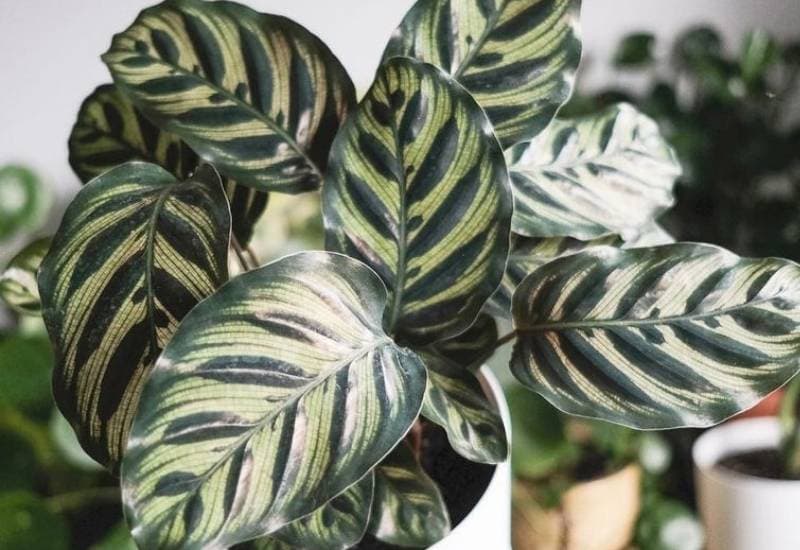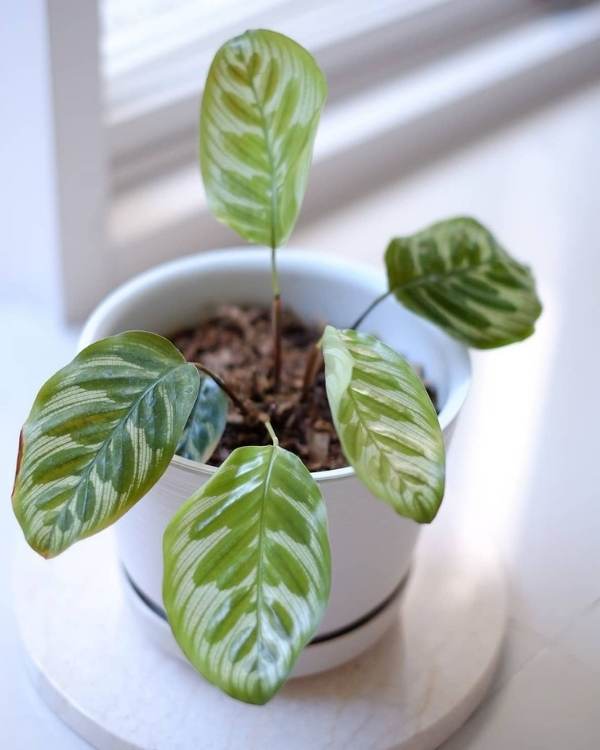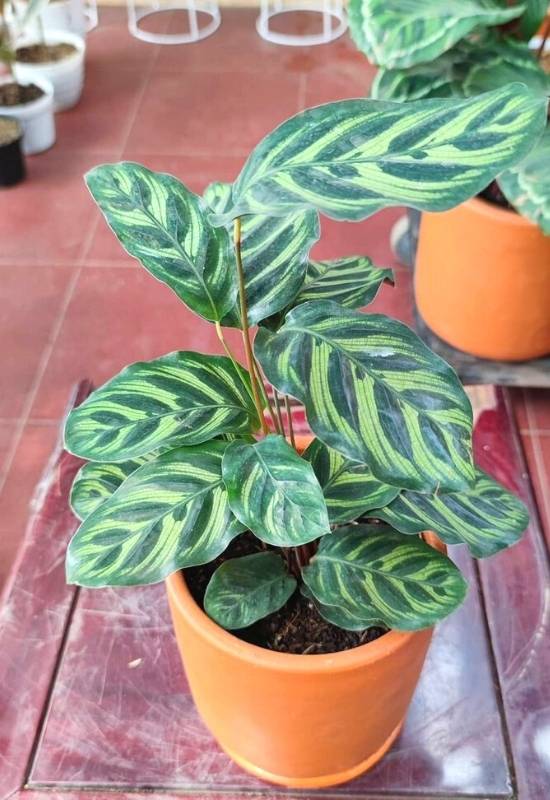The leaves share many of the characteristic Calathea traits, with dark green outlines and a waxy texture, but the makoyana distinguishes itself with a purple-maroon color on the undersides of the leaves.
The young leaves will appear entirely this color when rolled up, before they mature and spread out. It is particularly popular in homes with children and pets, as no parts of the plant are toxic.
Due to its tropical roots, the Calathea makoyana has specific care needs that must be addressed for it to thrive. In its native environment the makoyana would grow in the understory of the rainforest in relatively dark and damp conditions, so much of the care for this plant involves simulating its natural environment in the spot that you choose for it.
When its needs are met, this Calathea will add a splash of color and energy to your home and you won’t regret adding it to your indoor plant collection.
If you use the following guide to monitor its care, propagation, and troubleshoot any problems, then you shouldn’t have any problem keeping this elegant plant in great health.
Calathea Makoyana Plant Care Basics

All You Need To Know About Calathea Makoyana
Calathea makoyana can be grown indoors anywhere, and can be grown outdoors in USDA growing zones above 10a if kept under the shade of larger plants.
The makoyana is fairly average in size for the Calathea genus, with a height and spread of around 2ft. The leaves grow in a spiral pattern around the central stem, and the largest typically crown the plant at the top.
Because of its needs as a tropical plant, it is not well suited for beginner gardeners (unless you enjoy a challenge!). Make sure when purchasing to select a plant that is in good health, and do not confuse the purple undersides of the leaves with unhealthy plants that have browning leaf margins.
The topsides of the leaves will always have dark green patterns but the other colors may vary between shades of white, cream or may be yellow. Calatheas are monocots, meaning that they belong to the same group as most grasses and have a fibrous root structure underground.
Horticultural Classification | Family: Marantaceae, Genus: Calathea |
Plant can be 2 ft tall & leaves grow 10-12 inches long. | |
Soil must be kept moist but not soggy. | |
Slightly acidic (pH of 6.5), well-draining soil | |
Small flowers may appear throughout the year. | |
How To Care For The Peacock Plant (Calathea Makoyana)
Read on to better understand the specific conditions this plant needs to flourish, and troubleshoot any issues you may run into.
1: Peacock Plants Thrives in Bright, But Not Direct Sunlight

The Calathea makoyana would grow wild in the understory of the tropical forests of Brazil. To simulate this environment, place it in a bright room that gets indirect light; not directly in the shade but not under a beam of sunlight either.
A North facing window or beside a piece of furniture that blocks direct light are often good spots. If you can comfortably read in the chosen spot then that is a good indicator of whether it is bright enough.
If bright beams of sunlight hit the leaves, those spots will become bleached or the tips may turn brown.
On the flip side, if the space is too dark the growth of your makoyana will be stunted with less leaf growth and more faded colors. If you notice either of these issues you may need to move your plant to a more suitably lit spot.
2: Calathea Makoyana Enjoys The Warmth
Chances are that your house is already a suitable temperature for the Calathea makoyana, as they typically enjoy temperatures in the same range as humans.
Between 60 and 75 degree Fahrenheit will suit the peacock plant just fine, and try to avoid any sudden changes in temperature even within that range.
Also prevent keeping your plant near air conditioning units, vents, ovens or anything else that may disrupt the temperature or humidity around the plant.
If you live in a cooler climate, you can keep your peacock plant outdoors in the summer as long as the temperature stays above 50℉ day and night. The same rules still apply for shade and see below about humidity.
3: Peacock Plants Plants Enjoy A Humid Environment
Humidity is an important consideration when housing tropical plants, especially in the winter when indoor heating can significantly dry out your home.
The Calathea makoyana needs humidity to be at least 60%, which can be measured with a hygrometer. To increase humidity around the plant you can mist it with a spray bottle, put the pot on a tray of pebbles, or place it together with a group of other plants.
If you have a greenhouse with good airflow it could be a good spot for this peacock plant, but if you live in a city apartment, consider keeping it in your bathroom or your kitchen where humidity is usually the highest.
4: Lightweight and Airy Potting Mixture Is Works Best For Calathea Makoyana

To avoid root rot but keep the soil moist, make sure to select a potting soil with good drainage or add some components to improve this factor.
Perlite, pumice, orchid bark, or fine gravel can all improve soil drainage, and peat moss and compost will provide rich nutrients for your Calathea to feed on.
Orchid bark will decompose over time and should be replaced when re-potting. When choosing a potting soil check the pH, as this plant likes slightly acidic conditions at a pH of 6.5
5: Feed With General Houseplant Fertilizer Every Four Weeks During The Spring And Summer
You can give your Calathea makoyana a dose of fertilizer every month during the spring and summer. During the winter the plant will enter a period of slower growth and doesn’t need the extra energy. Use a well balanced liquid fertilizer with equal parts Nitrogen, Phosphorus and Potassium.
All Calatheas are sensitive to synthetic fertilizers that have high salt content, as it can build up in the soil and damage their root systems.
Water the plant the day before fertilizing so that the nutrients don’t shock and burn the roots. If the tips of the leaves begin to turn brown it could be a sign of over-fertilizing.
6: Watering: Keep Your Calathea Peacock Moist Not Soggy!
The soil of your Calathea makoyana should retain some moisture but the plant should never be sitting in water. Many tropical potted plants are overwatered and develop root rot, which is when the roots sit in boggy soil and begin to deteriorate.
It’s very difficult to remedy once it sets in, so generally air on the side of caution when watering your plant. Water your Calathea Peacock when the surface of the soil is dry a couple of times per week.
Ensure your soil has good drainage, and you can check this by using your sink to water it and let the water run until it drains out of the holes at the bottom.
Once it has stopped dripping the soil should be moist through but the roots won’t be sitting in stagnant water. If your pot becomes heavy with water and only a few drops are draining out, you may need to amend the soil matter with perlite or add drainage holes to your pot.
Another good tactic for watering is by using a spray bottle to give the soil a good misting, which also increases humidity. Use a damp cloth to wipe leaves if they are collecting dust.
7: Watch your Water

Calathea Peacock are are so sensitive when it comes to the type of water they receive. The fluoride and minerals often found in tap water can be damaging to your Calathea makoyana and cause discoloration on the surface of the leaves.
To avoid yellowing and browning leaves it’s best to water your Calathea Peacock with distilled or filtered water, or consider setting up a rainwater collector. If you don’t have the resources for any of these options you can use tap water, just let it sit in a glass on the counter for a few days to allow the minerals to dissipate before you use it for watering.
How to Prune a Calathea
Peacock plants do not need to be pruned often, and the pruning process is simple. Just remember not to do any pruning right after potting or re-potting when the plant is most stressed.
To prune your Calathea makoyana, just snip off any browning or damaged leaves at the base of the stem.
Any leaves that have been infected with disease or pests should be treated as damaged.
Dispose off all pruned leaves as they can spread disease if left on top of the soil, and make sure to sterilize all your cutting tools before using them on another plant.
Propagate Your Calathea Peacock Is Through Division
Peacock plants are most effectively reproduced by division. Here are the key steps to follow when propagating your Calathea makoyana:

Pests and Diseases
Although this Calathea Peacock plant is fairly resistant to most pests, aphids, spider mites, and scale can invade your Calathea makoyana. Often these pests are very small and can only be detected by signs such as small webs around the stems or discolored patches on the underside of leaves that are a yellowy brown color.
Aphids will latch onto the plant and suck out the sap, but they can be easily removed with a damp cloth or a garlic and water solution. Spider mites are tiny and will be on the undersides of leaves, also sucking on the plant’s nutrients.
They leave small webs around the plant and can cause quite a lot of damage if the population gets too big. Use diluted neem oil and apply where you see the webs and under leaves.
Neem oil is also a good tactic for scale, whose presence can be detected by yellow spots appearing on the tops of leaves. Pests will often lay eggs in the soil, so if you have treated an infestation it can be a good idea to repot with fresh soil.
Pseudomonas leaf spot is a bacterial disease that can develop from excess moisture on the leaves of your makoyana. It creates rust colored spots on the leaves that can distort them.
Treat by removing affected leaves and applying a baking soda and water solution, or if the problem persists an organic copper based bactericide.
I don’t have a humidifier, how do I keep my Calathea in a humid environment?
Many will opt to keep their Calathea makoyana in a bathroom or kitchen, where activities like hot showers and cooking keep humidity high. You could even keep it inside your shower where it will get a light misting, if lighting is adequate.
Otherwise, you can keep multiple tropical indoor plants together in a group and place the pot above a tray of water and pebbles to increase evaporation and create local humidity.
Placing some plastic sheeting around the plant can also create this effect for a lower price than buying a humidifier or a miniature greenhouse.
Help! My Calathea’s leaves are turning brown, what do I do?
Inadequate humidity or too little water are often the culprits of browning leaf tips on Calathea Peacock, and you may need to place your plant in a better spot and water it more frequently.
A good way to check whether it needs water is to stick your index finger in up to the first knuckle, and if it is dry at that depth you can assume it needs water.
Your plant may also be craving more light, or if it is near a window or a door that opens frequently that may be disturbing it.
If you have eliminated all of these causes, try changing your water source to something unfiltered and lay off the fertilizer for a while.
Why are the leaves of my Calathea makoyana curling?
Underwatering is typically the culprit, so make sure to give you Calathea a good soak and let any excess water drain out. Leaf curling can also be caused by too cool temperatures, so try increasing your thermostat by a degree or two.
When should I re-pot my Calathea makoyana?
Like most Calatheas, the makoyana does not like to be unnecessarily disturbed or messed with. Re-pot every one or two years unless there are specific circumstances like a major pest invasion or root rot that require you to do sooner.
Make sure to refresh the soil with more organic matter and peat moss, as well as supplements to improve drainage like orchid bark or perlite. Re-pot in the spring when the plant can bounce back more easily.
What size pot should I use?

Start small with newly propagated Calathea Peacock plants and pot up as needed. If you notice the plant is becoming root-bound that is a sign it needs a bigger pot. Containers that are 8-10 inches in diameter should suffice for a mature Calathea makoyana.
What kind of pot should I use?
Plastic pots inside of a decorative ceramic pot are ideal, as if ceramic or terra-cotta pots are in contact with the soil their porous texture can cause it to rapidly dry out.
The outer pot is used to collect draining water and a drainage tray works for this purpose as well.
 pyomn
pyomn



